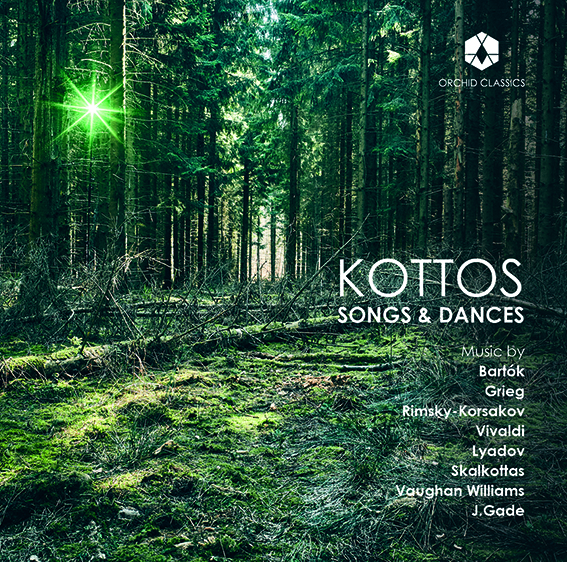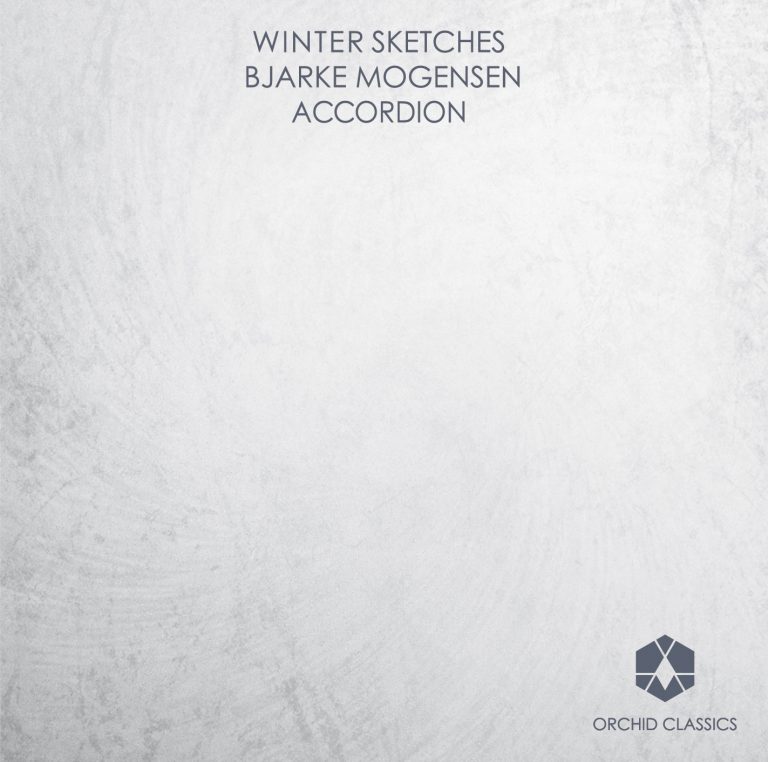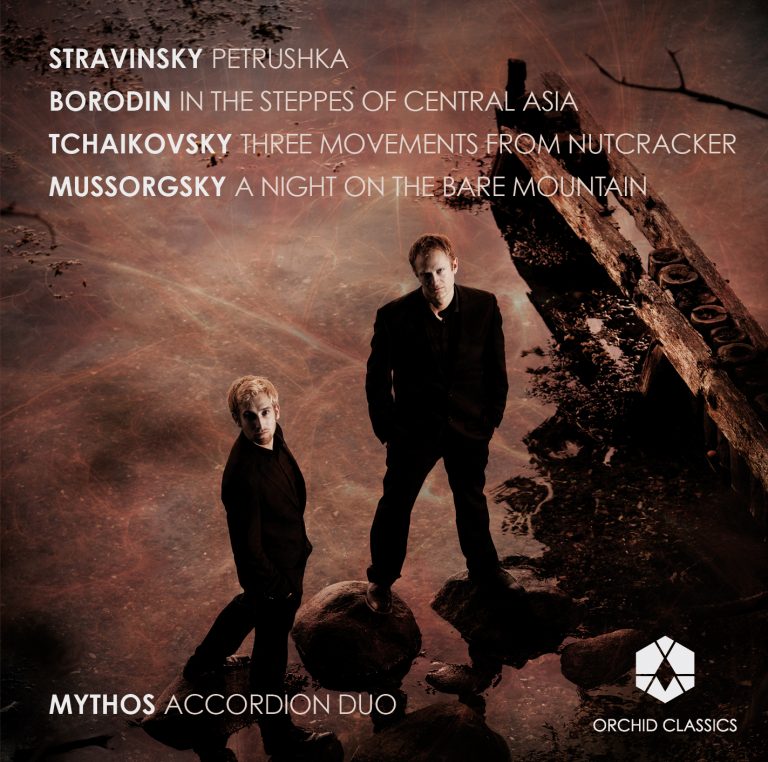Artist Led, Creatively Driven

KOTTOS
Songs and Dances
Release Date: October 4th 2019
ORC100105
KOTTOS
SONGS & DANCES
Nikos Skalkottas (1904-1949)
4 Greek Dances (from 36 Greek Dances for Orchestra) (arr. Farmakis)
1 Epirotikos 1.28
2 Kretikos 1.30
3 Kathistos (exc.) 2.04
4 Kleftikos 1.59
Anatoly Lyadov (1855-1914)
Russian Folk Songs Op.58 (arr. Mogensen)
5 Religious Chant. Moderato 2.04
6 Christmas Carol‘Kolyada’. Allegretto 1.22
7 Plaintive Song. Andante 2.59
8 Humorous Song ‘I Danced With The Gnat’. Allegretto 1.07
9 Legend Of The Birds ‘Bylina’. Allegretto 1.28
10 Cradle Song ‘Baju’. Moderato 2.03
11 Round Dance. Allegro 0.47
12 Village Dance Song. Vivo 1.31
Antonio Vivaldi (1678-1741)
13 La Folia (arr. Kottos) 6.02
Edvard Grieg (1844-1907)
14 Kulok, Op.17 No.22 (arr. Farmakis) 1.46
15 Norwegian Dance in D minor (arr. Mogensen, Petersen, Opsahl) 6.34
Béla Bartók (1881-1945)
Romanian Folk Dances, Sz.56 (arr. Farmakis)
16 I Stick Dance 1.11
17 II Sash Dance 0.50
18 III In One Spot 1.18
19 IV Dance from Bucsum 0.57
20 V Romanian Polka 0.30
21 VI Fast Dance 0.54
Ralph Vaughan Williams (1872-1958)
Six Studies in English Folk Song
22 1 Adagio 1.36
23 2 Andante sostenuto 1.18
24 3 Larghetto 1.36
25 4 Lento 1.39
26 5 Andante tranquillo 1.45
27 6 Allegro vivace 0.52
Nikolai Rimsky-Korsakov (1844-1908)
28 Sadko – ‘Song of India’ (arr. Petersen)3.06
29 Mlada – ‘Lithuanian Dance’ (arr. Mogensen, Petersen) 2.13
Jacob Gade (1879-1963)
30 Tango Jalousie (arr. Mogensen) 3.53
Total time 58.28
KOTTOS
Bjarke Mogensen, accordion
Pernille Petersen, recorder
Josefine Opsahl, cello
Christos Farmakis, bouzouki
Songs & Dances
Kottos, an ensemble that shouldn’t exist, has made its name playing music that didn’t exist – original scores and reactive improvisations delivered by the once-heard-never-forgotten combination of recorders, accordion, cello and bouzouki. But despite the fact of non-existence, this music felt like it always had; its notes as deep rooted as folk song and its strange assembly of timbres speaking of nowhere in particular and so, somehow, of everywhere.
Here we have music that absolutely does exist – on paper as well as in Europe’s collective cultural canon – even if the manner of its delivery is new. The ‘songs and dances’ of European folk music proved fertile ground for composers of the late nineteenth and early twentieth centuries, who recognized their validity in an age of rapid musical development. The works on this album are fruits of that recognition by beacon composers, journeying from the mountain tunes of Europe’s northernmost tip to the melancholy songs of its easternmost reaches (with some dances from its southernmost country, too).
But true to form, Kottos will combine the particular with the imagined. The ensemble’s distinctive combination of instruments renders these homespun, earthborn concert works in some way more authentic even in its inauthenticity. To tie the whole project back down to earth, this quartet which exists out of time and place has sought to root itself in the actual, factual geography of the works themselves. ‘We were attracted by the idea of folk songs and dances from very specific places that do actually exist,’ they say.
There is a tangible link to the album’s first destination in the form of Kottos’s bouzouki player Christos Farmakis, who grew up in Greece –homeland of the serial composer Nikos Skalkottas whose cycle of 36 Greek Dances was composed continually throughout his career. Skalkottas’s dances are unusually built, ‘Kathistos’ providing a particularly good example of his linear musical logic. Sometimes, his starting point is a tune from a particular place as in ‘Epirotikos’, inspired by a lament from Epirus. Elsewhere, as in ‘Kleftikos’, the theme is the composer’s own, fashioned in the image of his country’s accent and traditions. Even with Farmakis’s bouzouki underpinning his own arrangement, the sound broadens out beyond the Mediterranean.
In the decade before Skalkottas was born, a Russian who was struggling with many of the same demons as he sought similar rejuvenation in the folk music of his own country. Anatoly Lyadov spent much of the 1890s collecting indigenous tunes for the Imperial Geographic Society, a handful of which he arranged for orchestra in 1906. Lyadov was a miniaturist who famously failed to complete a single large-scale work; these pithy tunes suited him perfectly. He was also a man steeped in Russian traditions, and not always the sort that made their way into the classical music establishment.
The power of these songs is in their simplicity. Bjarke Mogensen’s telling arrangements have a whiff of authenticity (his 16kg Russian Bayan accordion helps and Farmakis’s bouzouki does a mean impersonation of a Russian balalaika) and don’t get in the way of the tunes even when adorning them or indulging in serious gameplay as in ‘Legend of the Birds’. In the pivotal ‘Plaintive Song’, Lyadov’s original cello retains its place as the cantor given Josefine Opsahl’s soulful rendition. ‘Village Dance Song’has rarely felt so real.
Lyadov’s colleague Nikolai Rimsky-Korsakov had no such problem with large-scale forms. While his junior was off collecting vernacular songs, Rimsky was writing sprawling mythical operas like magnified symphonic poems. They contained plenty of moments ripe for communicative music, as when the titular hero of Sadko (1896) is tempted to India and the cast jives to a Lithuanian tune in the midsummer festival from Mlada (1890). One is a song of seduction built here on breathing accordion and gently ticking bouzouki, while the other is a helter-skelter dance in which the recorder and cello are caught in the vortex.
Kottos might have looked and sounded a little less unusual in eighteenth-century Venice, where ensembles of recorder, strummed string instrument and bowed bass were standard (imagine the accordion as a small organ, and you have a totally Venetian ensemble). Variety of texture and improvisatory interplay were at the heart of Vivaldi’s set of variations on a popular tune of Spanish origin, La Folia, published in 1705 as his Opus 1. Vivaldi stretched the two leading violins of his own original instrumentation almost to breaking point but this collective arrangement goes even further.
Vernacular songs and dances became a fashion in central European concert halls but in Norway, where there were no grand concert halls to speak of, things were different. Edvard Grieg was channeling the spirit of folk music into concert works decades before Béla Bartók was, and in non-industrialized Norway the functionalism of the music wasn’t hidden or dignified by complex forms. Thus Grieg retained the title ‘Cowherd’ (‘Kulok’) in the twenty-second of his collection of Norwegian Folk Songs and Dances from 1895/96 and, despite the more complex approach (originally for piano duet and subjected to refraction and division by Kottos), the 1880 ‘Norwegian Dance No.1’ sought the same communal, aspirational ends.
In Hungary, Bartók was at the forefront of the avant-garde, using vernacular idioms, material and attitudes to fire his concert works with a new, edgy spirit. As different as the idea and its results were to those of Grieg, the fundamental method in Bartók’s Romanian Folk Dances was just as unfettered. The composer took six tunes he had recorded on a phonograph in Transylvania in 1910 and 1912, adding accompaniments that are modest but still excite, entice and pull at those tunes with harmonic and rhythmic suggestion. Bartók’s treatment, in both his chamber and orchestral versions, is direct, muddy and atmospheric. But a different and no less striking taste is left by Farmakis’s arrangement: ‘In One Spot’ ranges across borders with the quasi-Arabic sound of Pernille Petersen’s sopranino recorder while the tidal breath of Mogensen’s accordion brings an unforeseen depth to ‘Dance of Bucsum’.
While Bartók was collecting folk songs around Transylvania, Ralph Vaughan Williams was doing the same in Britain. His Six Studies in English Folk Song, first performed in 1926, contextualizes a handful of found tunes and dances with new accompaniments but elaborates the melodies too (like Grieg, Vaughan Williams consciously let the contours of the music he heard shape his own musical voice by osmosis). What is distinctly of one place is taken somewhere else by Mogensen’s timeless instrumentation, underlining the fact that it’s not all that distinctive at all: most of Europe’s folk traditions are rooted in the same scales, repetitions and harmonic spectrum. As such the accordion, with its low, brown notes, appears to root these pieces even deeper in the soil while taking them somewhere else –somewhere continental – at the same time.
Being absolutely of one place yet sounding like another is an apt description of a piece that is wholly Danish and wholly not: Tango Jalousie written in 1925 by the Vejle-born bandleader and violinist Jacob Gade. Never has this work beloved of Danes sounded more like the Argentinean music from which it took its inspiration than in this arrangement, where the accordion is both Stradivarius and bandoneon, the bouzouki both mandolin and guitar, the cello both gilded and gritty and the recorder a free spirit darting in between all three.
Andrew Mellor, 2019
KOTTOS
KOTTOS takes its name from a giant of Greek mythology: the son of Gaia (the earth) and Uranus (the sky). ‘Cottus’ had 100 arms and 50 heads; he was an enchanting and dangerous creature which the ensemble resembles in its playing.
The instrumental makeup of KOTTOS is unique: recorders ranging in size from the lowest bass to the highest sopranino; a 16kg Russian Bayan concert accordion with the weight and flavour of an orchestra; a foundation stone in the cello, which adds sounds from the avant-garde and Nordic folk music; and a Greek bouzouki to add unmistakably Mediterranean colour and sounds from the Celtic lands.
Besides creating and performing its own compositions, KOTTOS works with some of the most prominent Nordic composers of our time, some of whom have written works specifically for the ensemble’s unusual mix of instruments.
The group’s debut album KOTTOS, released in 2016, received the Listeners’ Prize of the Danish Broadcasting Corporation’s P2 station, for which it was nominated alongside recordings from the Berlin Philharmonic and National Danish Symphony Orchestra.









